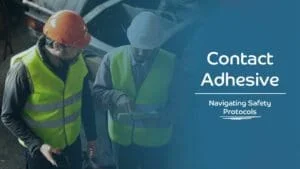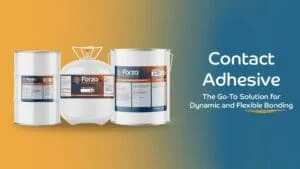Contact Cement vs Contact Adhesive: A Forza Perspective on Industrial Adhesion
In the industrial adhesives industry, ‘contact cement’ and ‘contact adhesive’ are more than just buzzwords. They’re key players in our arsenal of top-notch bonding solutions. Here at Forza, we’re not just about selling products; we’re about crafting solutions that lead the industry. Our expert team dives deep into the unique characteristics of these adhesives, ensuring you have the knowledge to pick the perfect fit for your projects. So, whether you’re a seasoned pro or just getting started, we’re here to guide you to the best adhesive for your needs. Let’s stick together and make your projects outstanding.
Deciphering the Bond: Contact Cement and Contact Adhesive
Contact Cement
This adhesive is renowned for its immediate and durable bond. Its unique formulation, typically comprised of neoprene or other synthetic rubbers, offers a resilient solution, particularly in high-stress applications. Once applied, contact cement requires a brief curing period, during which the solvents evaporate, leaving behind a tacky surface. When two treated surfaces are pressed together, the bond they form is almost instantaneous and permanently set. This characteristic makes contact cement an ideal choice for projects requiring rapid assembly and strong adherence, such as laminate countertops or automotive upholstery.
Contact Adhesive
Contact adhesives fall into a broader category and include a variety of chemical compositions, such as acrylic, polyurethane, and silicone-based formulas. Their versatility lies in their ability to be tailored for specific applications, from weatherproofing in construction to flexibility in automotive interiors. Unlike contact cement, some contact adhesives offer repositionable properties before setting completely, providing a degree of flexibility during application.
Forza’s Innovative Approach to Adhesive Solutions
Forza’s ethos revolves around innovation and customization. Our vertically integrated manufacturing process, combined with a robust in-house R&D laboratory, empowers us to develop adhesives that not only meet but exceed the industry’s evolving demands. Forza’s product range, including both contact cement and contact adhesives, is formulated with precision, ensuring optimal performance for a myriad of industrial applications.
Selecting the Right Adhesive for Your Needs
Choosing between contact cement and contact adhesive depends largely on the specific requirements of your project. For tasks necessitating rapid, permanent bonds under high-stress conditions, contact cement is your ally. However, for applications where versatility and adjustability are key, our range of contact adhesives offers a flexible and reliable solution.
Forza: Tailoring Solutions to Your Adhesive Challenges
At Forza, we understand that off-the-shelf solutions may not always align with your unique requirements. This is where our commitment to customization comes into play. If our existing range doesn’t quite fit your needs, just let us know. We are equipped and ready to develop a bespoke adhesive solution for you.
In Conclusion: Forza – Your Partner in Adhesive Innovation
The choice between contact cement and contact adhesive is more than a matter of preference; it’s about finding the right fit for your specific application. With Forza, you have a partner that not only supplies superior adhesive solutions but also supports you in making the right choice for your industrial needs.
Ready to find the perfect adhesive solution? Explore our range at Forza’s website. And remember, if we don’t have it, we offer custom solutions made just for you!
FAQs
What are the primary differences between contact cement and contact adhesive in terms of composition and application?
Contact cement and contact adhesive, though similar in their end purpose, differ significantly in composition and application. Contact cement is typically made from neoprene or other synthetic rubbers and requires a dry-fit application method. It’s known for its quick setting time and requires precise alignment since it bonds instantly upon contact. On the other hand, contact adhesive is usually a water or solvent-based adhesive and offers a bit more flexibility during application. It’s ideal for surfaces where repositioning may be needed and is generally more forgiving than contact cement. In terms of application, contact cement is often used for high-strength, permanent bonds, particularly in laminates, while contact adhesives are more common in the upholstery and automotive industries, where flexibility is key.
How does the choice of adhesive affect the longevity and durability of a project?
The longevity and durability of a project are heavily influenced by the choice of adhesive. Contact cement, being highly resistant to heat and other environmental factors, provides a very strong and long-lasting bond. It’s ideal for projects where durability is paramount. Contact adhesive, while still providing a strong bond, allows for some flexibility and movement, making it suitable for materials that may expand or contract. The right choice depends on the project’s requirements; for rigid, permanent bonds, contact cement is preferable, whereas for flexible, yet strong bonds, contact adhesive is more suitable.
Can environmental factors influence the effectiveness of these adhesives?
Yes, environmental factors can significantly impact the effectiveness of these adhesives. Contact cements are generally more resistant to heat, moisture, and chemicals, making them suitable for outdoor or high-stress environments. However, they can be vulnerable to failure if exposed to extreme temperatures beyond their tolerance. Contact adhesives are more sensitive to environmental conditions, especially those that are solvent-based, as they can be weakened by high humidity or extreme temperature variations. It’s crucial to consider the operational environment when selecting an adhesive for your project.
Are there specific industries or applications where one adhesive type is preferred over the other?
Indeed, certain industries and applications favor one type of adhesive over the other. Contact cement is highly favored in the woodworking, construction, and laminate industries due to its strong, irreversible bond. It’s ideal for countertops, cabinetry, and flooring applications. Contact adhesive, being more flexible, finds extensive use in the automotive, upholstery, and leather goods industries. It’s preferred for applications that require some degree of movement or flexibility, such as in car interiors or furniture.
How has adhesive technology evolved in recent years, and what are the future trends?
Adhesive technology has seen significant advancements in recent years, with a strong focus on eco-friendliness and enhanced performance. Innovations have led to the development of more environmentally friendly adhesives with reduced solvent content or entirely solvent-free compositions. There’s also been a push towards adhesives that offer greater strength and versatility and are capable of bonding a wider range of materials. Looking ahead, the trend is moving towards smart adhesives – those that can change properties in response to external stimuli, like temperature or light—and biodegradable adhesives for a more sustainable approach.
What are some tips for safely handling and applying these adhesives?
When handling and applying contact cement or adhesive, safety is paramount. Always work in a well-ventilated area to avoid inhalation of fumes, particularly with solvent-based adhesives. Wear appropriate protective gear, such as gloves and safety glasses, to prevent skin and eye contact. It’s important to read and follow the manufacturer’s instructions for application and curing times. Ensure surfaces are clean and dry before application for the best results. For contact cement, apply a thin, even layer to both surfaces and allow it to dry before joining. With contact adhesives, follow the specific instructions regarding open time and drying. Always store adhesives in a cool, dry place, away from heat sources and direct sunlight.



